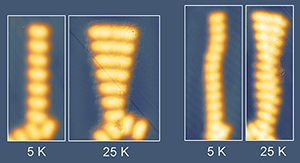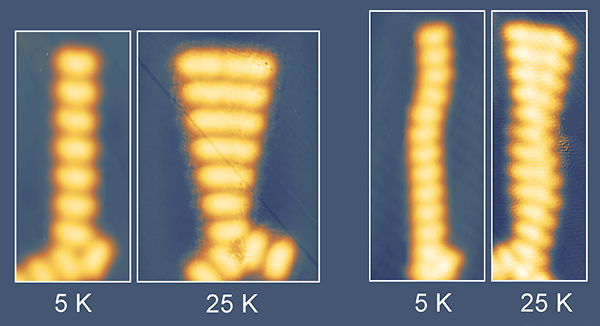Tuning in to the Smallest (Man-Made) Mechanical Resonator
Guitar strings, pendulums in clocks, and quartz crystals in watches are all examples of resonators. As their name suggests, resonators oscillate most strongly at specific frequencies (resonant frequencies), which depend on properties such as the resonator’s dimensions and mass. Musical instruments, for instance, produce sound waves of specific tones at their resonant frequencies.
Researchers in nanoscience have been pushing to make instruments of a different variety by fabricating truly minute resonators for both scientific and technological applications. Because of their small sizes, nanoresonators can oscillate at very high resonant frequencies, which makes them potentially useful for radio communication, small signal amplification, and sensing minute masses, forces, and quantum mechanical spin [1–4]. Writing in Physical Review Letters, Stefan Müllegger and his colleagues at the Johannes Kepler University in Austria report they can image and effectively “listen” to the oscillations of cantileverlike resonators made of just seven to twelve individual molecules—the smallest artificially fabricated resonators detected so far [5]. These nanoscale resonators are small enough that their resonant frequency varies with the addition of one extra molecule, a sensitivity that could be put to use to detect single molecules in certain experiments. They are also of fundamental interest because, unlike carbon nanotubes and other common nanoscale resonators, the molecules aren’t held together by strong chemical bonds.
Müllegger and his colleagues used a type of molecule called α, γ-bisdiphenylene- β-phenylallyl, or BDPA for short. In earlier work, they showed that when the BDPA molecules were deposited on the (111) crystallographic surface of gold [Au(111)], they accumulated in triangular clusters, some of which served as nucleation sites for a chain of molecules to grow in one direction and form tiny, cantileverlike structures [6]. Molecules in these structures are separated by about 0.73 nanometers and are more strongly attracted to each other than to the surface.
In their new work, the researchers imaged the molecules (Fig. 1) by running a scanning tunneling microscope (STM) tip back and forth across the chain and measuring the small electrical current between the tip and the gold surface. (At a fixed tip height, the amount of current depends on the presence of a molecule between the tip and the gold.) When the gold was held at a temperature of 5 kelvin ( K), the imaged BDPA chains looked like a line of molecules. But when the substrate temperature was raised to 20K or higher, the researchers observed that the molecules in the chain appeared wider or blurrier the further the tip was from the pinned end.
These images indicate the molecular chain is behaving like a vibrating string that is pinned down on one end (the node) and oscillating with a large amplitude (the antinode) at the free end. To understand this interpretation, consider how the blades of a fan appear when it is turned on: At first, the fan turns slowly, and each individual blade is clear. But at faster rotation speeds, the blades blur into a continuous circular shape because their rotation speed is much faster than our eyes can process their motion. Similarly, the back and forth movements of the vibrating molecules close to, or at, the antinode of the chains are much faster than the scanning speed of the STM used to image them and therefore appear blurry. In longer chains, the researchers see two blurry regions (two antinodes) and two nodes when they heat the substrate to 25K, images they therefore interpret as showing a higher harmonic of the oscillating chains.
The observation of node and antinode in molecular chains above 20K is clear evidence of a resonator. But a distinctive feature of these nanocantilevers is that they are formed of individual molecules that are only linked to each other by an attractive interaction, like beads connected by a string. It is therefore surprising that they can behave as resonators like carbon nanotubes [7], nanowires [8], or graphene sheets [9], in which the atoms form strong chemical bonds and the wavelength of the oscillation is long compared to the separation between the atoms. More importantly, the researchers can directly image node and antinode in these molecular chains. The length and mass of these molecular-chain resonators are also much smaller than the smallest free-standing nanomechanical resonators reported to date.
When we hear a musical note, we are using our ears as the detectors of the resonant frequency generated by the instrument that played it. Similarly, Müllegger and his colleagues have developed a technique that allows them to “tune in” to the tiny resonators. To achieve this, the researchers modified their microscope to detect tunneling currents in the radio frequency range. They parked the same STM tip used for imaging the molecules above one end of an oscillating molecule in a five-molecule chain and recorded the amplitude of the tunneling current generated by the molecule’s oscillation. They find that this chain of molecules oscillates at a resonant frequency of 98 megahertz ( MHz). Like instrument strings, these molecular-scale chains have resonant frequencies that decrease as the chain grows longer: the four-molecule chains resonate at ∼127MHz while seven-molecule chains resonate at ∼51MHz.
Molecules can self-assemble into larger structures, which can be used to engineer nanoscale devices inexpensively. Because of these structures’ low cost and their ability to operate as electronic, magnetic, and mechanical devices, scientists are studying self-assembled compounds made of natural and synthetic molecules to understand their physical properties and to explore potential technological applications. The work of Müllegger and his colleagues shows just how small a potentially useful, self-assembled molecular structure can be, and provides a new way to characterize these and, potentially, other nanoscale devices.
References
- K. Eom, H. S. Park, D. S. Yoon, and T. Kwon, “Nanomechanical Resonators and their Applications in Biological/Chemical Detection: Nanomechanics Principles,” Phys. Rep. 503, 115 (2011)
- M. D. LaHaye, O. Buu, B. Camarota, and K. C. Schwab, “Approaching the Quantum Limit of a Nanomechanical Resonator,” Science 304, 74 (2004)
- S. Kolkowitz, A. C. Bleszynski Jayich, Q. P. Unterreithmeier, S. D. Bennett, P. Rabl, J. G. E. Harris, and M. D. Lukin, “Coherent Sensing of a Mechanical Resonator with a Single-Spin Qubit,” Science 335, 1603 (2012)
- F. Massel, T. T. Heikkila, J.-M. Pirkkalainen, S. U. Cho, H. Saloniemi, P. J. Hakonen, and M. A. Sillanpa, “Microwave Amplification with Nanomechanical Resonators,” Nature 480, 351 (2011)
- Stefan Müllegger, Mohammad Rashidi, Karlheinz Mayr, Michael Fattinger, Andreas Ney, and Reinhold Koch, “Radio-Wave Oscillations of Molecular-Chain Resonators,” Phys. Rev. Lett. 112, 117201 (2014)
- S. Müllegger, M. Rashidi, M. Fattinger and R. Koch, “Interactions and Self-Assembly of Stable Hydrocarbon Radicals on a Metal Support,” J. Phys. Chem. C 116, 22587 (2012)
- V. Sazonova, Y. Yaish, H. Üstünel, , D. Roundy, T. A. Arias, and P. L. McEuen, “A Tunable Carbon Nanotube Electromechanical Oscillator,” Nature 431, 284 (2004)
- A. Husain, J. Hone, H. W. Ch. Postma, X. M. H. Huang, T. Drake, M. Barbic, A. Scherer, and M. L. Roukesa, “Nanowire-Based Very-High-Frequency Electromechanical Resonator,” Appl. Phys. Lett. 83, 1240 (2003)
- J. S. Bunch, A. M. van der Zande, S. S. Verbridge, I. W. Frank, D. M. Tanenbaum, J. M. Parpia, H. G. Craighead, and P. L. McEuen, ”Electromechanical Resonators from Graphene Sheets,” Science 315, 490 (2007)





